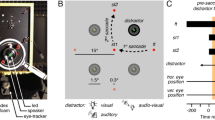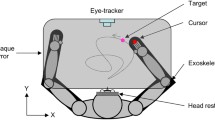Abstract
We investigated the relationship between compensation for the effects of smooth pursuit eye movements in localization and motion perception. Participants had to indicate the perceived motion direction, the starting point and the end point of a vertically moving stimulus dot presented during horizontal smooth pursuit. The presentation duration of the stimulus was varied. From the indicated starting and end points, the motion direction was predicted and compared with the actual indicated directions. Both the directions predicted from localization and the indicated directions deviated from the physical directions, but the errors in the predicted directions were larger than those in the indicated directions. The results of a control experiment, in which the same tasks were performed during fixation, suggest that this difference reflects different transformations from a retinocentric to a head-centric frame of reference. This difference appears to be mainly due to an asymmetry in the effect of retinal image motion direction on localization during smooth pursuit.






Similar content being viewed by others
References
Andersen RA (1989) Visual and eye movement functions of the posterior parietal cortex. Annu Rev Neurosci 12:377–403
Andersen RA, Mountcastle V (1983) The influence of the angle of gaze upon the excitability of the light-sensitive neurons of the posterior parietal cortex. J Neurosci 3:532–548
Andersen RA, Essick GK, Siegel RM (1985) Encoding of spatial location by posterior parietal neurons. Science 230:456–458
Andersen RA, Essick GK, Siegel RM (1987) Neurons of area 7 activated by both visual stimuli and oculomotor behavior. Exp Brain Res 67:316–322
Aubert H (1886) Die Bewegungsempfindung. Pflügers Archiv 39:347–370
Aubert H (1887) Die Bewegungsempfindung, zweite Mitteilung. Pflügers Archiv 40:459–480
Barton JJS, Simpson T, Kiriakopoulos E, Stewart C, Crawly A, Guthrie B, Wood M, Mikulis D (1996) Functional MRI of lateral occipitotemporal cortex during pursuit and motion perception. Ann Neurol 40:387–398
Becklen R, Wallach H, Nitzberg D (1984) A limitation of position constancy. J Exp Psychol: Hum Percept Perform 10:713–723
Bradley DC, Maxwell M, Andersen RA, Banks MS, Shenoy KV (1996) Mechanisms of heading perception in primate visual cortex. Science 273:1544–1547
Brenner E, Smeets J, Van den Berg AV (2001) Smooth eye movements and spatial localisation. Vis Res 41:2253–2259
De Graaf B, Wertheim AH (1988) The perception of object-motion during smooth-pursuit eye movements: adjacency is not a factor contributing to the Filehne illusion. Vis Res 28:497–502
Dichgans J, Wist ER, Diener HC, Brandt T (1975) The Aubert-Fleischl phenomenon: a temporal frequency effect on perceived velocity in afferent motion perception. Exp Brain Res 23:529–533
Ehrenstein WH, Mateeff S, Hohnsbein J (1986) Temporal aspects of position constancy during ocular pursuit. Pflügers Archiv — Eur J Physiol 406:R15, 47
Festinger L, Sedgwick HA, Holtzman JD (1976) Visual perception during smooth pursuit eye movements. Vis Res 16: 1377–1386
Filehne W (1922) Über das optische Wahrnehmen von Bewegungen. Zeitschrift für Sinnesphysiologie 53:134–144
Freeman TCA (2000) Unequal retinal and extra-retinal motion signals produce different perceived slants of moving surfaces. Vis Res 40:1857–1868
Freeman TCA (2001) Transducer models of head-centred motion perception. Vis Res 41: 2741–2755
Freeman TCA, Banks MS (1998) Perceived head-centric speed is affected by both extra-retinal and retinal errors. Vis Res 38:941–945
Hansen RM (1979) Spatial localization during pursuit eye movements. Vis Res 19:1213–1221
Hazelhoff FF, Wiersma H (1924) Die Wahrnehmungszeit. Zeitschrift für Psychologie 96:171–188
Hazelhoff FF, Wiersma H (1925) Die Wahrnehmungszeit. Zeitschrift für Psychologie 97:174–190
Hill AL (1972) Direction constancy. Percept Psychophys 11:175–178
Ilg UJ, Thier P (2003) Visual tracking neurons in primate area MST are activated by smooth-pursuit eye movements of an “imaginary target”. J Neurophysiol 90:1489–1502
Loftus GR, Masson ME (1994) Using confidence intervals in within-subject designs. Psychon Bull Rev 1:476–490
Mack A, Herman E (1973) Position constancy during pursuit eye movement: an investigation of the Filehne illusion. Q J Exp Psychol 25:71–84
Mack A, Herman E (1978) The loss of position constancy during pursuit eye movements. Vis Res 18:55–62
Masson MEJ, Loftus GR (2003) Using confidence intervals for graphically based data interpretation. Can J Exp Psychol 57:203–220
Mateeff S (1978) Saccadic eye movements and localization of visual stimuli. Percept Psychophys 24:215–224
Mateeff S, Hohnsbein J (1988) Perceptual latencies are shorter for motion towards the fovea than for motion away. Vis Res 28:711–719
Mateeff S, Hohnsbein J (1989) The role of the adjacency between background cues and objects in visual localization during ocular pursuit. Perception 18:93–104
Mateeff S, Yakimoff N, Dimitrov G (1981) Localization of brief visual stimuli during pursuit eye movements. Acta Psycholo 48:133–140
Mateeff S, Yakimoff N, Hohnsbein J, Ehrenstein WH, Bohdanecky Z, Radil T (1991) Selective directional sensitivity in visual motion perception. Vis Res 31:131–138
Matin L, Matin E, Pearce DG (1969) Visual perception of direction when voluntary saccades occur. I. Relation of visual direction of a fixation target extinguished before a saccade to a flash presented during the saccade. Percept Psychophys 5:65–80
Matin L, Matin E, Pola J (1970) Visual perception of direction when voluntary saccades occur. II. Relation of visual direction of a fixation target extinguished before a saccade to a subsequent test flash presented before the saccade. Percept Psychophys 8:9–14
Mita T, Hironaka K, Koike I (1950) The influence of retinal adaptation and location on the “Empfindungszeit”. Tohoku J Exp Med 52:397–405
Mitrani L, Dimitrov G (1982) Retinal location and visual localization during pursuit eye movement. Vis Res 22:1047–1051
Müsseler J, Van der Heijden AHC, Mahmud SH, Deubel H, Ersey S (1999) Relative mislocalization of briefly presented stimuli in the retinal periphery. Percept Psychophys 61:1646–1661
Newsome WT, Wurtz RH, Komatsu H (1988) Relation of cortical areas MT and MST to pursuit eye movements. II. Differentiation of retinal from extraretinal inputs. J Neurophysiol 60:604–620
Pack C, Grossberg S, Mingolla E (2001) A neural model of smooth pursuit control and motion perception by cortical area MST. J Cognit Neurosci 13:102–120
Park J, Lee J, Lee C (2001) Non-veridical visual motion perception immediately after saccades. Vis Res 41:3751–3761
Rauber H-J, Treue S (1998) Reference repulsion when judging the direction of visual motion. Perception 27:393–402
Rotman G, Brenner E, Smeets JBJ (2004) Quickly tapping targets that are flashed during smooth pursuit reveals perceptual mislocalisations. Exp Brain Res 156:409–414
Rotman G, Brenner E, Smeets JBJ (2005) Flashes are localized as if they were moving with the eyes. Vis Res 45:355–364
Schlag J, Schlag-Rey M (2002) Through the eye, slowly: delays and localization errors in the visual system. Nat Rev — Neurosci 3:191–200
Shenoy KV, Bradley DC, Andersen RA (1999) Influence of gaze rotation on the visual response of primate MSTd neurons. J Neurophysiol 81:2764–2786
Smeets JB, Brenner E (1995) Perception and action are based on the same visual information: distinction between position and velocity. J Exp Psychol: Hum Percept Perform 21:19–31
Snowden RJ (1994) Motion processing in the primate cerebral cortex. In: Smith AT, Snowden RJ (eds) Visual detection of motion. Academic, London, pp 51–83
Souman JL, Hooge ITC, Wertheim AH (2005a) Vertical object motion during horizontal ocular pursuit: compensation for eye movements increases with presentation duration. Vis Res 45:845–853
Souman JL, Hooge ITC, Wertheim AH (2005b) Perceived motion direction during smooth pursuit eye movements. Exp Brain Res 164:376–386
Souman JL, Hooge ITC, Wertheim AH (in press) Frame of reference transformations in motion perception during smooth eye movements. J Comput Neurosci
Sumi S (1971) The apparent displacement of a moving light spot. Psychologische Forschung 34:349–360
Swanston MT, Wade NJ (1988) The perception of visual motion during movements of the eyes and of the head. Percept Psychophys 43:559–566
Swanston MT, Wade NJ, Day RH (1987) The representation of uniform motion in vision. Perception 16:143–159
Turano KA, Heidenreich SM (1999) Eye movements affect the perceived speed of visual motion. Vis Res 39:1177–1187
Turano KA, Massof RW (2001) Nonlinear contribution of eye velocity to motion perception. Vis Res 41:385–395
Van Beers RJ, Wolpert DM, Haggard P (2001) Sensorimotor integration compensates for visual localization errors during smooth pursuit eye movements. J Neurophysiol 85:1914–1922
Van der Heijden AHC, Van der Geest JN, De Leeuw F, Krikke K, Müsseler J (1999) Sources of position-perception error for small isolated targes. Psychol Res 62:20–35
Von Fleischl E (1882) Physiologisch-optische Notizen. Sitzungsberichte der Akademie der Wissenschaften in Wien 3:7–25
Wade NJ, Swanston MT (1996) A general model for the perception of space and motion. Perception 25:187–194
Ward F (1976) Pursuit eye movements and visual localization. In: Monty RA, Senders JW (eds) Eye movements and psychological processes. Wiley, New York
Wertheim AH (1987) Retinal and extraretinal information in movement perception: how to invert the Filehne illusion. Perception 16:299–308
Wertheim AH (1994) Motion perception during self-motion: the direct versus inferential controversy revisited. Behavi Brain Sci 17:293–355
Wertheim AH, Van Gelder P (1990) An acceleration illusion caused by underestimation of stimulus velocity during pursuit eye movements: Aubert-Fleischl revisited. Perception 19:471–482
Author information
Authors and Affiliations
Corresponding author
Rights and permissions
About this article
Cite this article
Souman, J.L., Hooge, I.T. & Wertheim, A.H. Localization and motion perception during smooth pursuit eye movements. Exp Brain Res 171, 448–458 (2006). https://doi.org/10.1007/s00221-005-0287-4
Received:
Accepted:
Published:
Issue Date:
DOI: https://doi.org/10.1007/s00221-005-0287-4




